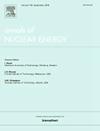Experimental investigation for radiation shielding performance of B2O3-TeO2-Bi2O3-ZnO-CaO glass system
IF 1.9
3区 工程技术
Q1 NUCLEAR SCIENCE & TECHNOLOGY
引用次数: 0
Abstract
This work investigated the gamma-ray attenuation capability of four glass compositions labeled as BTBZC-1, BTBZC-2, BTBZC-3 and BTBZC-4, with fixed amount of Bi2O3 and TeO2 (5 and 20 mol%, respectively), while the CaO and B2O3 decrease from 17 to 8 mol% (in 3 mol% decrement) and 38 to 32 mol% (in 2 mol% decrement), and the ZnO increases from 20 to 35 mol% (in 5 mol% increment). The data was evaluated experimentally using narrow beam method by different point sources and semiconductor detector (HPGe-detector). Experimental data are compared with theoretical predictions (Phy-X software), demonstrating strong agreement with R2 values of 1. The LAC at 0.059 MeV is in the 12.332–13.146 cm−1 range, decreasing at 0.662 MeV to 0.331–0.345 cm−1, thus revealing the prepared glasses to exhibit high shielding efficiency at low energies, primarily due to the photoelectric effect’s dominance, while Compton scattering at higher energies leads to reduced attenuation. The addition of ZnO improves the shielding performance by increasing glass density and Zeff, as confirmed by lower HVL, TVL, and MFP values. The investigation highlights these glasses’ potential for radiation protection, with BTBZC-4 exhibiting superior performance due to its higher ZnO content.
求助全文
约1分钟内获得全文
求助全文
来源期刊

Annals of Nuclear Energy
工程技术-核科学技术
CiteScore
4.30
自引率
21.10%
发文量
632
审稿时长
7.3 months
期刊介绍:
Annals of Nuclear Energy provides an international medium for the communication of original research, ideas and developments in all areas of the field of nuclear energy science and technology. Its scope embraces nuclear fuel reserves, fuel cycles and cost, materials, processing, system and component technology (fission only), design and optimization, direct conversion of nuclear energy sources, environmental control, reactor physics, heat transfer and fluid dynamics, structural analysis, fuel management, future developments, nuclear fuel and safety, nuclear aerosol, neutron physics, computer technology (both software and hardware), risk assessment, radioactive waste disposal and reactor thermal hydraulics. Papers submitted to Annals need to demonstrate a clear link to nuclear power generation/nuclear engineering. Papers which deal with pure nuclear physics, pure health physics, imaging, or attenuation and shielding properties of concretes and various geological materials are not within the scope of the journal. Also, papers that deal with policy or economics are not within the scope of the journal.
 求助内容:
求助内容: 应助结果提醒方式:
应助结果提醒方式:


